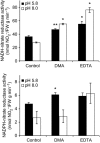2'-Deoxymugineic acid promotes growth of rice (Oryza sativa L.) by orchestrating iron and nitrate uptake processes under high pH conditions
- PMID: 25393516
- PMCID: PMC4309410
- DOI: 10.1111/tpj.12722
2'-Deoxymugineic acid promotes growth of rice (Oryza sativa L.) by orchestrating iron and nitrate uptake processes under high pH conditions
Abstract
Poaceae plants release 2'-deoxymugineic acid (DMA) and related phytosiderophores to chelate iron (Fe), which often exists as insoluble Fe(III) in the rhizosphere, especially under high pH conditions. Although the molecular mechanisms behind the biosynthesis and secretion of DMA have been studied extensively, little information is known about whether DMA has biological roles other than chelating Fe in vivo. Here, we demonstrate that hydroponic cultures of rice (Oryza sativa) seedlings show almost complete restoration in shoot height and soil-plant analysis development (SPAD) values after treatment with 3-30 μm DMA at high pH (pH 8.0), compared with untreated control seedlings at normal pH (pH 5.8). These changes were accompanied by selective accumulation of Fe over other metals. While this enhanced growth was evident under high pH conditions, DMA application also enhanced seedling growth under normal pH conditions in which Fe was fairly accessible. Microarray and qRT-PCR analyses revealed that exogenous DMA application attenuated the increased expression levels of various genes related to Fe transport and accumulation. Surprisingly, despite the preferential utilization of ammonium over nitrate as a nitrogen source by rice, DMA application also increased nitrate reductase activity and the expression of genes encoding high-affinity nitrate transporters and nitrate reductases, all of which were otherwise considerably lower under high pH conditions. These data suggest that exogenous DMA not only plays an important role in facilitating the uptake of environmental Fe, but also orchestrates Fe and nitrate assimilation for optimal growth under high pH conditions.
Keywords: 2′-deoxymugineic acid; Oryza sativa L.; alkali tolerance; iron; nitrate assimilation; nitrate transport; plant growth.
© 2014 The Authors The Plant Journal published by Society for Experimental Biology and John Wiley & Sons Ltd.
Figures






References
-
- Araki R, Hasegawa H. Expression of rice (Oryza sativa L.) genes involved in high-affinity nitrate transport during the period of nitrate induction. Breed. Sci. 2006;56:295–302.
-
- Araki R, Murata J, Murata Y. A novel barley yellow stripe 1-like transporter (HvYSL2) localized to the root endodermis transports metal–phytosiderophore complexes. Plant Cell Physiol. 2011;52:1931–1940. - PubMed
-
- Bashir K, Inoue H, Nagasaka S, Takahashi M, Nakanishi H, Mori S, Nishizawa NK. Cloning and characterization of deoxymugineic acid synthase genes from graminaceous plants. J. Biol. Chem. 2006;281:32395–32402. - PubMed
-
- Cai C, Wang JY, Zhu YG, Shen QR, Li B, Tong YP, Li ZS. Gene structure and expression of the high-affinity nitrate transport system in rice roots. J. Integr. Plant Biol. 2008;50:443–451. - PubMed
Publication types
MeSH terms
Substances
LinkOut - more resources
Full Text Sources
Other Literature Sources
Medical
Molecular Biology Databases

